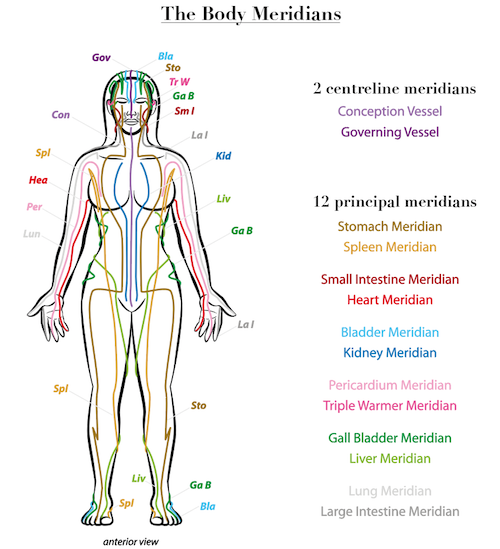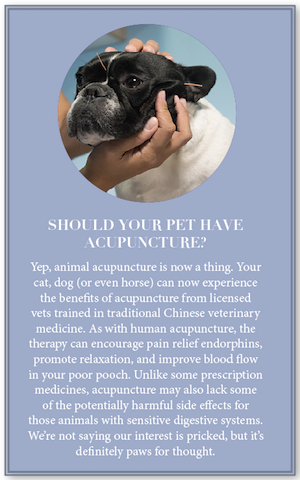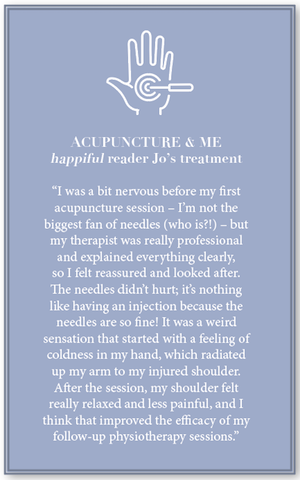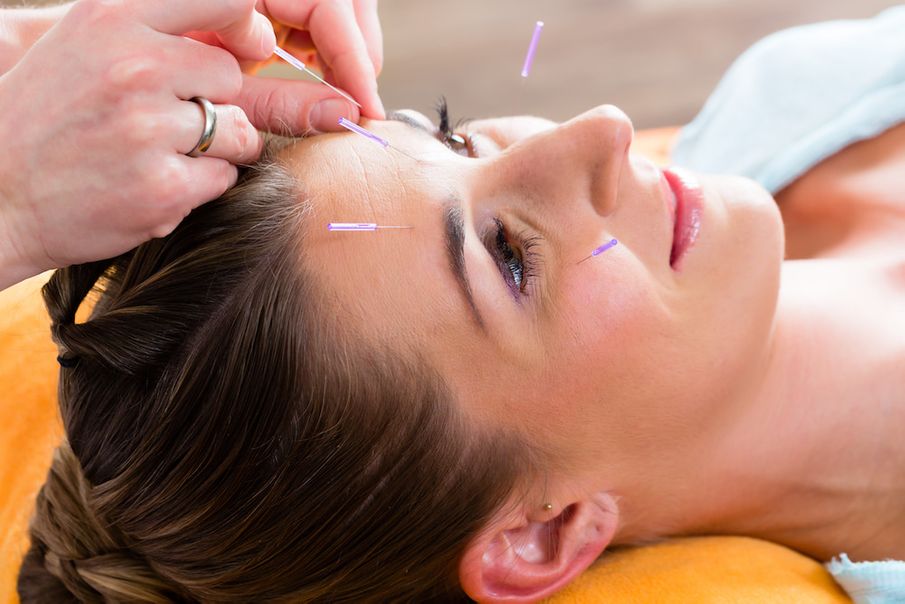If you have persistent neck or back pain, you might want to try this traditional Chinese treatment. But does acupuncture work? Is it safe? And how can wellness pass through the eye of a needle?
Chinese acupuncture is an ancient traditional therapy that looks to resolve illnesses and pain through the insertion of hair-fine needles into points on the body in order to bring harmony to the body’s energy flow or qi (pronounced “chee”). Practitioners believe that when the body’s qi gets blocked by factors such as stress or poor eating habits, pain and illness can occur. Fine needles are inserted into the body’s energy focal points – called meridians – to stimulate the flow of energy in these areas and rebalance your qi. Here’s how it works.

Where did acupuncture originate?
Dating back some 2,000 years, Chinese acupuncture is a treatment that derives from traditional Chinese medicine (TCM) for therapeutic and preventative purposes. The aim is to allow the optimum flowing of a person’s qi to encourage the body’s natural healing processes to flourish. The first known book of TCM, from which all styles of modern acupuncture can trace their roots, dates back to the Han Dynasty between the first century BC and the first century AD.
Qi is a cornerstone of TCM and encompasses both the physical energy from our muscles and the emotional energy we feel. When a person is in good spirits, happy and healthy, it is believed that their qi is balanced. As with the Japanese holistic therapy Reiki, this energy flows through the meridians in the body. These points are the key places for an acupuncturist to focus on to rebalance the person’s qi by stimulating the energy with needles.
Today, acupuncture is a popular alternative therapy, and is even a recommended complementary treatment by the NHS. Some GPs and physiotherapists, as well as the NHS, can offer acupuncture treatment, but with limited access. The majority of people experiencing the treatment in the UK will go private. Western acupuncture is a variation of traditional Chinese acupuncture that takes place after a medical diagnosis. Rather than focusing on energy flow, it looks to stimulate the nerves under the skin. Endorphins are released into the body through this stimulation and are believed to cause pain relief.
The National Institute for Health and Care Excellence (NICE) recommends acupuncture as a treatment for migraines and chronic tension-type headaches. Outside of NICE guidelines, acupuncture is also used to treat chronic pain, joint pain, dental pain and post-operative pain.

What’s the scientific support?
While studies are yet to find conclusive evidence of the positive effects of acupuncture on the whole, several recent studies’ results have found positive implications from the treatment.
A new paper published in June in The Journal of Physiological Sciences by Yukyung Lee et al. investigated the effect of acupuncture stimulation on the regulation of oxidative stress, which is a potential contributor to Parkinson’s disease. They gave mice acupuncture treatments over 12 days and found that it does seem to have a neuroprotective effect.
Another new study published in May in Clinical and Experimental Rheumatology by Cristina Lannuccelli et al. researched the pain-relieving effect of acupuncture on patients with fibromyalgia, a musculoskeletal condition. They found that acupuncture could be used as a complementary therapy to focus on neuropeptide Y (a neurotransmitter), which is used in pain modulation.
While these studies’ sample sizes are small, they do support the benefits of acupuncture for pain relief. They might not have found an effective way to prove or disprove whether qi and the meridians are real, but as one of the most popular therapies in the UK – 2.3 million acupuncture treatments were carried out last year – it sure seems to be working just fine for the British public.
How does the treatment work?

The first thing to stress is that the needles used in acupuncture are not the same size as those for injections – so those with a phobia of needles needn’t worry. An acupuncture needle can actually be as small as 0.12mm wide, and will feel more like a tingling sensation than a pin prick when inserted.
Firstly, an acupuncturist will have a consultation with you to find out what ailments you might have, and to learn about your medical history. As this is a holistic therapy, the therapist will be looking to learn about your lifestyle in general to understand how your energies might have been blocked. They’ll devise a treatment plan with you, which is likely to require a number of sessions, and may also advise on some lifestyle changes as well.
The needles are pre-sterilised and single-use, so there should be no fear of contamination – it’s a very safe practice. Depending on where the needles will be placed, you may have to remove parts of clothing. As with any therapy, it’s absolutely fine to let your therapist know if you’re uncomfortable with removing anything.
The needles are inserted into the skin depending on where the practitioner needs to stimulate your qi to achieve the necessary results. They can go deeper to affect your muscle tissue if needed. The acupuncturist will then leave you with the needles in place for around 30 minutes, for the treatment to maximise its benefits.

What happens after treatment?
Most people describe feeling very relaxed afterwards, so it’s advised to be careful if you’re driving home. Also, drink plenty of water, and avoid alcohol. The treatment will hopefully reduce any chronic pain you’ve been experiencing, however this may take several sessions. Acupuncture can help you sleep better too, and can help with migraines.
Some people have found that acupuncture can even help reduce feelings of nausea, as well as helping reduce the pain associated with arthritis.
While for the most part people will feel a deep, positive relaxation following treatment, a few people might experience the odd side effect. This tends to be a sensation of fatigue or slight muscle ache, but most people should find a welcoming emotional release. This is believed to be the body’s energies being unblocked, but any reactions should be discussed with the acupuncturist to ensure you receive the most effective treatment possible for you.
Visit Therapy Directory to find an acupuncturist near you, or to learn more about this ancient Chinese traditional therapy.


Comments